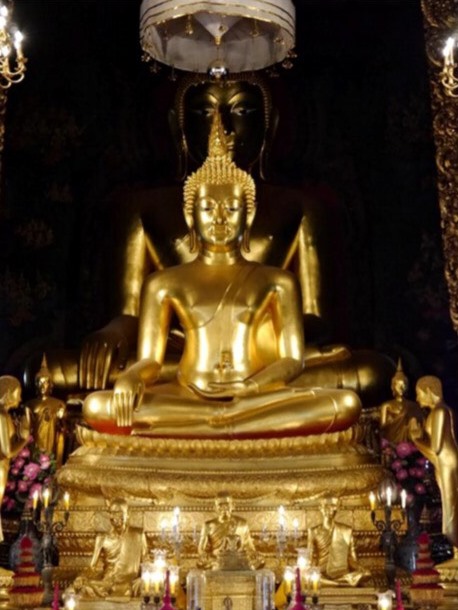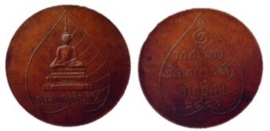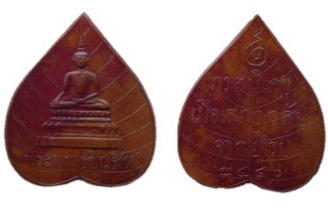Jirasak Inthawichai*
A Buddha statue is a religious object and an embodiment of faith. There may be two ideas behind the making of a Buddha statue. The first is Tathagata Bodhi Sattha or the belief in the enlightened wisdom of the Buddha. The second is that a buddha statue is an object stupa or an object to represent the Buddha. These ideas result in great numbers of buddha statues being made in Thai culture. The designs according to the king’s or the ruling elites’ commission, or those which receive Royal fondness are especially popular, and have great influence over believers. Phra Buddha Chinnasi is one of this kind. The statue remains one of the most revered Buddha statues in Thailand until the present day largely due to its long history involving the monarchy. Moreover, such importance has also made the statue an image of choice for medals since the reign of King Rama V.
Phra Buddha Chinnasi (front) and Phra Buddha Suwannakhet (back)
are located in the main Ubosot at Wat Bowonniwet Ratchaworawihan
History
At present, Phra Buddha Chinnasi is located in the main ubosot at Wat Bowonniwet Ratchaworawihan, Bangkok. According to the Annal on the Northern Cities, Phra Buddha Chinnasi was commissioned along with Phra Buddha Chinnarat, and Phra Si Satsada by Phaya Li Thai around 1357. It was first located in the north vihara of Wat Phra Si Rattana Mahathat in Phitsanulok until the early Rattanakosin period. In 1829, Somdet Phra Bowonmahasak Polasep proceeded to move the Buddha statue to the portico behind the ubosot at Wat Bowonniwet. In 1849 CE, the Buddha statue was moved by Wachirayan Bhikkhu, who would later reigned as King Mongkut (King Rama IV), to the front hall of the ubosot. It was placed in front of Phra Buddha Suwannakhet. According to Wachirayan Bhikkhu’s order, the ushnisha or the Buddha’s crown of hair of the Buddha statue was newly plated with gold, while the eyes and the urna were decorated with diamonds, and the entire statue was newly gilded. In 1851, the King commissioned that the ushnisha was newly gilded, and enamelled with colours. The Buddha statue was decorated with a nine-tiered umbrella, a piece of shoulder cloth, a pair of decorative metal trees in gold and silver. In 1855, the king commissioned a stand for the Buddha statue made of bronze, gilded with gold. The Buddha statue itself was also again gilded. The king ordereded a 5-day royal celebration on this occasion. Then, in 1866, upon the King’s return from paying his respect to Phra Buddha Chinnarat, the King commissioned another celebration. This time, the King granted a jade ring to decorate the Buddha’s thumb, and donated 50 chang’s worth of money.
Later in 1891, King Chulalongkorn (King Rama V) ordered the re-gilding of the Buddha statue, and a celebration along with the celebration of the renovation of the monastery which was also completed according to the king’s commission. During the royal procession on the occasion of the coronation of King Vajiravudh (King Rama VI), the King paid respect to Phra Buddha Chinnasi, and granted a pair of golden and silver tree for decoration. After the king’s death, the king’s ashes was stored in the pedestal of Phra Buddha Chinnasi. Moreover, Wat Bowanniwet was subsequently made the temple of King Rama VI. It could not have been more clear that the kings of Chakri dynasty bestowed their ardent faith in this Buddha statue. Additionally, the enamelled top knot of Phra Buddha Chinnasi is changed yearly on the royal Kathin event or the annual robe-offering ceremony granted by the king, until the present day.

The Buddha’s crown of hair of Phra Buddha Chinnasi
Source: Pichai Yindeenoi
Charateristics
Phra Buddha Chinnasi is a bronze statue, in the earth-witness gesture. It is measured 2.80 metres from one knee to another, and 3.72 metres in height. It was made according to Sukhothai style of art by the craftsmanship of Phitsanulok school. It is considered to belong to the category of Phra Bhuddha Chinnarat. The characteristics that are special to this type include having an oval-shaped face, the body being more chubby than that of Sukhothai type, the four fingers being of an even length. The name of the Buddha statue is a combination of two words—Chi na and Si ha, which means that one who is triumphant like the lion. The name is to convey the greatness of Buddha. These particular characteristics as well as its long history has drawn great attention, especially of the kings who were traditionally the patron of Buddhism. Consequently, Phra Buddha Chinnasi became a popular choice for the creation of religious objects in many forms, for example replicas statue, or amulets with the image of this particular model.
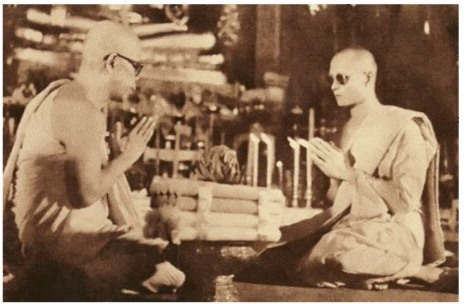
King Bhumibol Adulyadej or King Rama IX (Bhumi Palo Bhikkhu) as a monk
sitting in front of Phra Buddha Suwannakhet and Phra Buddha Chinnasi
at the Ubosot at Wat Bowonniwet Ratchaworawihan
Phra Buddha Chinnasi on Medals
1. Medals on the occasion of the king’s return from his first official visit to Europe in 1897
Medals on the occasion of the king’s return from his first official visit to Europe in 1897
Source: Chatchawan Woowanich and others, Coins produced in the Riegn of King Rama V. Bangkok: Commonsense Design and Print, 2006.
This was the first time the image of Phra Buddha Chinnasi appeared on a medal. There are two designs. The first was round, with a smooth rim, and 42 mm in diameter. On the obverse is the image of Phra Buddha Chinnasi on a pedestal designed like the legs of a singha, placed in the centre of a Bodhi leaf design. At the bottom is a text which reads ‘Phra Bhuddha Chinnasi’. On the reverse side, there is an urna symbol at top, and a text which reads ‘The Celebration of the Return of the King from Europe 2440’. It is assumed that this was the test model. The second design is cut in the shape of a Bodhi leaf which is assumed to be the finished model. It is measured 29 mm in width, 34 mm in length. Both designs were made of gold-plated silver, silver, and bronze. They were created overseas, hence the exceptionally high quality, clear, and beautiful design for the time. Furthermore, these medals are significant in that they were the first medals on which an image of a Buddha statue appeared in Thailand. It is assumed that they were made for the following purposes:
1) To celebrate Phra Buddha Chinnasi statue as an important statue that enjoyed the reverence of both the kings and the people of Siam.
2) To commemorate King Rama V as the first king who completed an official visit to Europe. In order to complete this trip, the king had to endure 8-month of hardship in a boat across the oceans. The medals are to express the loyalty of the people towards the king.
3) To commemorate Somdet Phramahasamanachao Kromphraya Watchirayanawarorot, the brother of King Rama V, as the abbot of Wat Bowonniwet Vihara. It is assumed that using the image of Phra Buddha Chinnasi was his idea because the celebration ceremony was mainly held under his supervision. Additionally, it was by his order that the Sangha prayed to bless and to praise the king on this occasion.
This batch of medals are called ‘Rian Pu’, and are very popular among the circle of amulet collectors. They are very rare; there was no record of how many were made.
In the beginning of King Rama IX’s reign, King Bhumibol Adulyadej along with Queen Sirikit travelled several times overseas. Upon every departure and return, the king and the queen would pay respect to Phra Buddha Chinnasi. It is believed that this custom was a result of the creation of the medals in the year 1897. Plus, a batch of medals were also commissioned for this occasion. They were made in the shape of a Bodhi leaf; other details remained the same. The only exception was the text on the medals which says, ‘To Commemorate the Return from the Royal Visit to the United States and Europe, 18 January 2504 B.E.’.
Bodhi leaf-shaped medals on the occasion of the king’s return from his first official visit to Europe in 1897
Source: Chatchawan Woowanich and others, Coins produced in the Riegn of King Rama V. Bangkok: Commonsense Design and Print, 2006.
2. Medals for [the commemoration of] altar table-setting at Wat Bowonniwet Vihara, 1904
Due to its importance, the image of Phra Buddha Chinnasi was again chosen to be used on medals in 1904. These medals are called ‘the honour medals for altar table-setting at Wat Bowonniwet Vihara’ or Phra Buddha Chinnasi medals. The medals were designed in the shape of a flame, 27 mm in width, and 32 mm in length. Some were found to have holes so that they can be connected with hoops. On the obverse is an image of Phra Buddha Chinnasi on a pedestal of lotus and singha design. There is a writing ‘Buddha’ On the left side and ‘Chinnasi’ on the right side. On the reverse there is a text ‘To commemorate the altar table setting on the occasion of the Royal Kathin at Wat Bowonniwet Vihara 1/8/123’. The medals were made of silver, bronze, and gold-plated bronze. They were assumed to have been a prize for the winners of the altar table setting competition. In this period, it was popular among high-ranking officials, wealthy people, antique collectors and Chinaware collectors to compete in table setting competition using chinaware or porcelain imported from China. Another purpose for these medals might have been to commemorate the royal visit to offer the robe at the Royal Kathin event at Wat Bowonniwet. It is assumed that King Rama V or a member of the royal family might have attended the ceremony which took place on 1 August 123 Minor Era or 2447 Buddhist Era or 1904 Common Era. Thus, the medals that in this occasion were made with an intention to capture the spirit of the time and the place. They reflect the habit of collecting items which was a Chinese influence, as well as the Buddhist essence in a royal ceremony in Thailand.

Medals for [the commemoration of] altar table-setting at Wat Bowonniwet Vihara, 1904
Source: Chatchawan Woowanich and others, Coins produced in the Riegn of King Rama V. Bangkok: Commonsense Design and Print, 2006.
3. Phra Buddha Chinnasi Medals in the Buddha Panja Phakhi set, 1996
On this occasion, the image of Phra Buddha Chinnasi residing in the middle of Bodhi leaf design was again chosen. The only difference in design is that only a lotus pedestal was present in the design. The medals were made as an object of worship for Thai people, as well as to reflect the greatness of King Bhumibol Adulyadej as the Patron of all religions on the occasion of the Golden Jubilee. The medals are of an oval shape, with a flat rim. The obverse is the image of King Bhumibol Adulyadej facing right. Along the rim is a text which reads ‘Bhumibol Adulyadej Borommarachathirat’. The reverse is the image of Phra Buddha Chinnasi. At the bottom is a symbol of the mint along with the texts ‘2539’ and ‘Phra Buddha Chinnasi’, respectively. Along the top rim, there is a text which says ‘Made for the Golden Jubilee’. These medals were made of gold, silver, and bronze. There are 412,000 medals created in total. This production has shown that Phra Buddha Chinnasi is one of the five most important, most revered Buddha statues at that time. Hence, it was the choice for commemoration in this utmost auspicious ceremony.
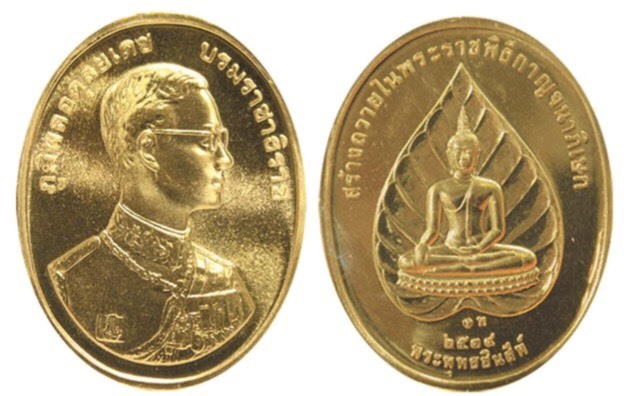
Phra Buddha Chinnasi Medals in the Buddha Panja Phakhi set, 1996
The image of Phra Buddha Chinnasi has always been popular. It was chosen for several other important occasions. For example, the medals with an image of Phra Buddha Chinnasi on tamarind leaves were created to celebrate the seventh cycle, or 84th anniversary of Somdet Phra Sangharaja Chao Kromma Luang Vajirananavongs in 195. Other productions include medals to commemorate the return from the royal visit to the United States and Europe, 18 January 1961, Phra Buddha Chinnasi medals of 1973, the medals ญสส Y.S.S to celebrate the promotion of Somdet Nyanasamvara, who later would become 19th Supreme Patriarch of Thailand.
In sum, Phra Buddha Chinnasi is one of the most important Buddha statues in Thailand. Its beauty is due to the greatness of the craftsmanship of Phitsanulok School, according to Sukhothai art style. It has long history, enjoying the reverence of all Kings in the Rattanakosin period. Additionally, its location is at the centre of the Thai Sangha; the temple has been a residence of several Supreme Patriarch. Thus, the image of Phra Buddha Chinnasi is also the image of faith which has been transmitted to the all believers incessantly throughout the years.
* Curator, Practitioner Level at Bureau of Grand National Treasure under the Treasury Department

